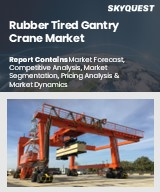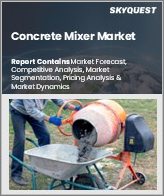
|
시장보고서
상품코드
1573791
세계의 냉간 용접 금형 시장 : 금형 유형별, 재료별, 프로세스 유형별, 용도별, 최종 이용 산업별 - 예측(2025-2030년)Cold Welding Dies Market by Die Type (Combination Die, Compound Die, Multiple Cavity Die), Material (Alloys, Metals, Non-Metals), Process Type, Application, End-Use Industry - Global Forecast 2025-2030 |
||||||
냉간 용접 금형 시장은 2023년에 7억 9,887만 달러로 평가되었고, 2024년에는 8억 3,398만 달러로 추정되며, CAGR 5.67%로 성장할 전망이고, 2030년에는 11억 7,589만 달러에 도달할 것으로 예상됩니다.
냉간 용접 금형은 제조 산업의 중요한 구성 요소이며 주로 열이나 융합 공정이 필요없는 금속 접합에 사용됩니다. 이 방법은 재료를 가압하고 용접하기 때문에 열 변형이나 오염이 없는 깨끗하고 고강도 접합부의 제조에 필수적입니다. 냉간 용접 금형의 필요성은 알루미늄, 구리 및 이들의 합금을 포함한 광범위한 금속에 대응하는 능력에서 태어나며 항공우주, 자동차, 전자 장비와 같은 정확성과 재료 무결성이 중요한 산업에 이상적입니다. 냉간 용접 금형의 주요 용도는 전자 전도성 및 열 전도성 유지가 중요한 금속 공작물과 부품의 조립입니다. 최종 용도의 범위는 가볍고 내구성이 있으며 환경 친화적인 구조를 중시하는 분야에도 적용됩니다.
| 주요 시장 통계 | |
|---|---|
| 기준년(2023년) | 7억 9,887만 달러 |
| 예측년(2024년) | 8억 3,398만 달러 |
| 예측년(2030년) | 11억 7,589만 달러 |
| CAGR(%) | 5.67% |
시장 성장의 원동력은 자동차 및 항공우주 부품의 경량화 수요 증가, 지속 가능하고 에너지 효율적인 제조 공정의 추진, 금형 설계 기술의 진보입니다. 냉간 용접 금형과 자동화 및 디지털화된 제조 시스템의 통합은 생산 효율과 정밀도를 향상시킬 수 있습니다. 지속가능성이 주목되고 있는 동안, 재활용가능하거나 생분해가능한 금형 재료의 개발에는 추가적인 가능성이 있습니다. 그러나 높은 초기 비용, 특정 유형의 금속을 다룰 때의 기술적 한계, 정밀 가공된 금형의 복잡성 등의 문제가 성장을 방해할 수 있습니다. 이러한 제약을 극복하기 위해서는 신소재와 첨단 제조 기술에 초점을 맞춘 연구개발이 필요합니다.
혁신 분야에는 합금 적합성 향상, 마모에 강한 견고한 금형 재료 개발, 예지 보전을 위한 IoT 통합 등이 포함됩니다. 또한 전도성 및 비부식성 재료 결합이 필수적인 신재생 에너지와 같은 고가치 분야를 목표로 함으로써 사업 성장을 가속할 수 있습니다. 시장 관계자는 냉간 용접 공정 최적화에 AI 및 머신러닝을 활용하기 위해 고객 교육 및 하이테크 기업과의 제휴에 투자해야 합니다. 전반적으로 시장은 완만한 성장을 특징으로 하며, 제조 혁신과 환경 기준을 선호하는 지역에서의 기회가 증가하고 있습니다.
시장 역학 : 급속히 진화하는 냉간 용접 금형 시장의 주요 시장 인사이트 공개
냉간 용접 금형 시장은 수요 및 공급의 역동적인 상호 작용에 의해 변모하고 있습니다. 이러한 시장 역학의 진화를 이해함으로써 기업은 충분한 정보를 바탕으로 투자결정, 전략적 결정 정밀화, 새로운 비즈니스 기회 획득에 대비할 수 있습니다. 이러한 동향을 종합적으로 파악함으로써 기업은 정치적, 지리적, 기술적, 사회적, 경제적인 영역에 걸친 다양한 리스크를 경감할 수 있음과 동시에, 소비자 행동과 그것이 제조 비용이나 구매 동향에 미치는 영향을 보다 명확하게 이해할 수 있습니다.
- 시장 성장 촉진요인
- 지속가능성에 대한 관심의 고조가 종래의 방법보다 냉간 용접에 대한 투자 촉진
- 정밀하고 고성능의 용접 솔루션을 요구하는 자동차 산업 확대
- 냉간 용접 공정의 최적화를 목표로 한 연구 개발 활성화
- 시장 성장 억제요인
- 냉간 용접 기술의 비용이 높기 때문에 소규모 산업에서의 채용 제한
- 접착 접합 및 납땜과 같은 기존의 대체 방법은 냉간 용접에 큰 경쟁 제공
- 시장 기회
- 항공우주 산업과 자동차 산업에서의 고정밀 제조에 대한 수요 증가가 냉간 용접 금형 시장 활성화
- 재료 과학의 기술 진보가 냉간 용접 금형 용도의 혁신 촉진
- 신재생 에너지 인프라 투자 증가가 냉간 용접 금형 제품의 비즈니스 기회 창출
- 시장의 과제
- 고품질의 냉간 용접 금형의 생산에서 비용면에서의 과제 극복
- 경쟁 시장에서의 냉간 용접 금형 제조를 위한 숙련 노동자 확보
Porter's Five Forces : 냉간 용접 금형 시장을 탐색하는 전략 도구
Porter's Five Forces 프레임 워크는 냉간 용접 금형 시장 경쟁 구도를 이해하는 중요한 도구입니다. Porter's Five Forces 프레임 워크는 기업의 경쟁력을 평가하고 전략적 기회를 탐구하는 명확한 기술을 제공합니다. 이 프레임 워크는 기업이 시장 내 세력도를 평가하고 신규 사업의 수익성을 결정하는 데 도움이 됩니다. 이러한 인사이트를 통해 기업은 자사의 강점을 활용하고, 약점을 해결하고, 잠재적인 과제를 피할 수 있으며, 보다 강인한 시장에서의 포지셔닝을 보장할 수 있습니다.
PESTLE 분석 : 냉간 용접 금형 시장에서 외부로부터의 영향 파악
외부 거시 환경 요인은 냉간 용접 금형 시장의 성과 역학을 형성하는 데 매우 중요한 역할을 합니다. 정치적, 경제적, 사회적, 기술적, 법적, 환경적 요인 분석은 이러한 영향을 탐색하는 데 필요한 정보를 제공합니다. PESTLE 요인을 조사함으로써 기업은 잠재적인 위험과 기회를 더 잘 이해할 수 있습니다. 이 분석을 통해 기업은 규제, 소비자 선호, 경제 동향의 변화를 예측하고 앞으로 예상되는 적극적인 의사 결정을 할 준비를 할 수 있습니다.
시장 점유율 분석 : 냉간 용접 금형 시장 경쟁 구도 파악
냉간 용접 금형 시장의 상세한 시장 점유율 분석을 통해 공급업체의 성과를 종합적으로 평가할 수 있습니다. 기업은 수익, 고객 기반, 성장률 등 주요 지표를 비교하여 경쟁 포지셔닝을 밝힐 수 있습니다. 이 분석을 통해 시장 집중, 단편화, 통합 동향을 밝혀내고 벤더들은 경쟁이 치열해지는 가운데 자사의 지위를 높이는 전략적 의사 결정을 내리는 데 필요한 지식을 얻을 수 있습니다.
FPNV 포지셔닝 매트릭스 : 냉간 용접 금형 시장에서 공급업체의 성능 평가
FPNV 포지셔닝 매트릭스는 냉간 용접 금형 시장에서 공급업체를 평가하는 중요한 도구입니다. 이 행렬을 통해 비즈니스 조직은 공급업체의 비즈니스 전략과 제품 만족도를 기준으로 평가하여 목표에 맞는 충분한 정보를 바탕으로 의사 결정을 내릴 수 있습니다. 네 가지 사분면을 통해 공급업체를 명확하고 정확하게 세분화하여 전략 목표에 가장 적합한 파트너 및 솔루션을 파악할 수 있습니다.
전략 분석 및 추천 : 냉간 용접 금형 시장에서 성공에 대한 길을 그립니다.
냉간 용접 금형 시장의 전략 분석은 세계 시장에서의 존재를 강화하려는 기업에 필수적입니다. 주요 자원, 능력 및 성과 지표를 검토함으로써 기업은 성장 기회를 파악하고 개선을 위해 노력할 수 있습니다. 이러한 접근 방식을 통해 경쟁 구도에서 과제를 극복하고 새로운 비즈니스 기회를 활용하여 장기적인 성공을 거둘 수 있는 체제를 구축할 수 있습니다.
이 보고서는 주요 관심 분야를 포괄하는 시장의 종합적인 분석을 제공합니다.
1. 시장 침투 : 현재 시장 환경의 상세한 검토, 주요 기업의 광범위한 데이터, 시장 도달범위 및 전반적인 영향력을 평가합니다.
2. 시장 개척도 : 신흥 시장의 성장 기회를 파악하고 기존 분야의 확장 가능성을 평가하며 미래 성장을 위한 전략적 로드맵을 제공합니다.
3. 시장 다양화 : 최근 제품 출시, 미개척 지역, 업계의 주요 진보, 시장을 형성하는 전략적 투자를 분석합니다.
4. 경쟁 평가 및 정보 : 경쟁 구도를 철저히 분석하여 시장 점유율, 사업 전략, 제품 포트폴리오, 인증, 규제 당국 승인, 특허 동향, 주요 기업의 기술 진보 등을 검증합니다.
5. 제품 개발 및 혁신 : 미래 시장 성장을 가속할 것으로 예상되는 최첨단 기술, 연구개발 활동, 제품 혁신을 강조합니다.
또한 이해관계자가 충분한 정보를 얻고 의사결정을 할 수 있도록 중요한 질문에 대답하고 있습니다.
1. 현재 시장 규모 및 향후 성장 예측은?
2. 최고의 투자 기회를 제공하는 제품, 부문 및 지역은 어디입니까?
3. 시장을 형성하는 주요 기술 동향 및 규제의 영향은?
4. 주요 벤더의 시장 점유율 및 경쟁 포지션은?
5. 벤더 시장 진입 및 철수 전략의 원동력이 되는 수익원과 전략적 기회는 무엇인가?
목차
제1장 서문
제2장 조사 방법
제3장 주요 요약
제4장 시장 개요
제5장 시장 인사이트
- 시장 역학
- 성장 촉진요인
- 지속가능성에 대한 관심 고조에 따라 종래의 방법보다 냉간 용접에 대한 투자 촉진
- 정밀하고 고성능의 용접 솔루션을 요구하는 자동차 산업 확대
- 냉간 용접 공정의 최적화를 목표로 한 연구 개발 활동 강화
- 억제요인
- 냉간 용접 기술의 고비용으로 소규모 산업에서의 도입 제한
- 접착 접합 및 납땜과 같은 기존의 대체 방법은 냉간 용접과 큰 경쟁
- 기회
- 항공우주 산업과 자동차 산업에 있어서의 고정밀 제조 수요 증가가 냉간 용접 금형 시장
- 재료 과학의 기술적 진보가 냉간 용접 금형 용도에 있어서의 혁신 추진
- 신재생 에너지 인프라에 대한 투자 증가로 냉간 용접 금형 제품에 기회 발생
- 과제
- 고품질 생산에 있어서의 비용의 과제를 극복하는 냉간 용접 금형
- 경쟁이 심한 시장에서 제조업의 숙련 노동자 확보 냉간 용접 금형
- 성장 촉진요인
- 시장 세분화 분석
- Porter's Five Forces 분석
- PESTEL 분석
- 정치적
- 경제
- 사교
- 기술적
- 법률상
- 환경
제6장 냉간 용접 금형 시장 : 금형 유형별
- 조합 금형
- 복합 금형
- 멀티 캐비티 금형
- 프로그레시브 금형
- 싱글 캐비티 금형
제7장 냉간 용접 금형 시장 : 소재별
- 합금
- 니켈 합금
- 티타늄 합금
- 금속
- 알루미늄
- 강철
- 비금속
- 도예
- 플라스틱
제8장 냉간 용접 금형 시장 : 프로세스 유형별
- 고체 용접
- 열가소성 플라스틱 용접
제9장 냉간 용접 금형 시장 : 용도별
- 항공우주
- 기체
- 엔진
- 자동차
- 바디
- 섀시
- 패널
- 엔진 부품
- 바디
- 전기
- 커넥터
- 스위치
- 일반 공학
- 기계
- 도구
제10장 냉간 용접 금형 시장 : 최종 이용 산업별
- 항공우주 및 방위
- 민간 항공기
- 군용기
- 자동차
- 상용차
- 승용차
- 일렉트로닉스
- 가전
- 산업용 전자 기기
제11장 아메리카의 냉간 용접 금형 시장
- 아르헨티나
- 브라질
- 캐나다
- 멕시코
- 미국
제12장 아시아태평양의 냉간 용접 금형 시장
- 호주
- 중국
- 인도
- 인도네시아
- 일본
- 말레이시아
- 필리핀
- 싱가포르
- 한국
- 대만
- 태국
- 베트남
제13장 유럽, 중동 및 아프리카의 냉간 용접 금형 시장
- 덴마크
- 이집트
- 핀란드
- 프랑스
- 독일
- 이스라엘
- 이탈리아
- 네덜란드
- 나이지리아
- 노르웨이
- 폴란드
- 카타르
- 러시아
- 사우디아라비아
- 남아프리카
- 스페인
- 스웨덴
- 스위스
- 터키
- 아랍에미리트(UAE)
- 영국
제14장 경쟁 구도
- 시장 점유율 분석(2023년)
- FPNV 포지셔닝 매트릭스(2023년)
- 경쟁 시나리오 분석
- 전략 분석 및 제안
The Cold Welding Dies Market was valued at USD 798.87 million in 2023, expected to reach USD 833.98 million in 2024, and is projected to grow at a CAGR of 5.67%, to USD 1,175.89 million by 2030.
Cold welding dies are critical components in the manufacturing sector, primarily employed in joining metals without the need for heat or fusion process. This method relies on applying pressure to weld materials, making it essential for producing clean, high-strength joints without thermal distortion or contamination. The necessity of cold welding dies arises from their ability to work with a wide range of metals, including aluminum, copper, and their alloys, making them ideal for industries such as aerospace, automotive, and electronics, where precision and material integrity are crucial. The primary application of cold welding dies is in the assembly of metal workpieces and components, where maintaining electronic and thermal conductivity is vital. End-use scopes extend to sectors focused on lightweight, durable, and environmentally friendly construction.
| KEY MARKET STATISTICS | |
|---|---|
| Base Year [2023] | USD 798.87 million |
| Estimated Year [2024] | USD 833.98 million |
| Forecast Year [2030] | USD 1,175.89 million |
| CAGR (%) | 5.67% |
The market's growth is driven by increasing demand for lightweight automotive and aerospace components, the push towards sustainable and energy-efficient manufacturing processes, and advancements in die design technologies. Opportunities abound in the integration of cold welding dies with automated and digital manufacturing systems, enhancing production efficiency and precision. As sustainability becomes a focal point, further potential lies in developing recyclable or biodegradable die materials. However, challenges such as high initial costs, technical limitations in handling certain metal types, and the intricacies of precision-engineered dies can impede growth. Overcoming these limitations requires focused R&D into new materials and advanced manufacturing techniques.
Innovation areas include enhancing alloy compatibility, developing robust die materials resistant to wear, and integrating IoT for predictive maintenance. Furthermore, business growth can be stimulated by targeting high-value sectors such as renewable energy, where conductive and non-corrosive material bonds are essential. Market players should invest in customer education and partnerships with tech firms to leverage AI and machine learning in optimizing cold welding processes. Overall, the market is characterized by moderate growth with increasing opportunities in regions prioritizing manufacturing innovation and environmental standards.
Market Dynamics: Unveiling Key Market Insights in the Rapidly Evolving Cold Welding Dies Market
The Cold Welding Dies Market is undergoing transformative changes driven by a dynamic interplay of supply and demand factors. Understanding these evolving market dynamics prepares business organizations to make informed investment decisions, refine strategic decisions, and seize new opportunities. By gaining a comprehensive view of these trends, business organizations can mitigate various risks across political, geographic, technical, social, and economic domains while also gaining a clearer understanding of consumer behavior and its impact on manufacturing costs and purchasing trends.
- Market Drivers
- Rising focus on sustainability driving investment in cold welding over traditional methods
- Expansion of automotive industry demanding precision and high-performance welding solutions
- Increased research and development activities aimed at optimizing cold welding process
- Market Restraints
- The high cost of cold welding technology limits its adoption in small-scale industries
- Existing alternative methods such as adhesive bonding and soldering pose significant competition to cold welding
- Market Opportunities
- Growing demand for high-precision manufacturing in aerospace and automotive industries fuels cold welding dies market
- Technological advancements in materials science drive innovation in cold welding dies applications
- Increasing investments in renewable energy infrastructure create opportunities for cold welding dies products
- Market Challenges
- Navigating the cost challenges in the production of high-quality cold welding dies
- Ensuring the availability of skilled labor for manufacturing cold welding dies in a competitive market
Porter's Five Forces: A Strategic Tool for Navigating the Cold Welding Dies Market
Porter's five forces framework is a critical tool for understanding the competitive landscape of the Cold Welding Dies Market. It offers business organizations with a clear methodology for evaluating their competitive positioning and exploring strategic opportunities. This framework helps businesses assess the power dynamics within the market and determine the profitability of new ventures. With these insights, business organizations can leverage their strengths, address weaknesses, and avoid potential challenges, ensuring a more resilient market positioning.
PESTLE Analysis: Navigating External Influences in the Cold Welding Dies Market
External macro-environmental factors play a pivotal role in shaping the performance dynamics of the Cold Welding Dies Market. Political, Economic, Social, Technological, Legal, and Environmental factors analysis provides the necessary information to navigate these influences. By examining PESTLE factors, businesses can better understand potential risks and opportunities. This analysis enables business organizations to anticipate changes in regulations, consumer preferences, and economic trends, ensuring they are prepared to make proactive, forward-thinking decisions.
Market Share Analysis: Understanding the Competitive Landscape in the Cold Welding Dies Market
A detailed market share analysis in the Cold Welding Dies Market provides a comprehensive assessment of vendors' performance. Companies can identify their competitive positioning by comparing key metrics, including revenue, customer base, and growth rates. This analysis highlights market concentration, fragmentation, and trends in consolidation, offering vendors the insights required to make strategic decisions that enhance their position in an increasingly competitive landscape.
FPNV Positioning Matrix: Evaluating Vendors' Performance in the Cold Welding Dies Market
The Forefront, Pathfinder, Niche, Vital (FPNV) Positioning Matrix is a critical tool for evaluating vendors within the Cold Welding Dies Market. This matrix enables business organizations to make well-informed decisions that align with their goals by assessing vendors based on their business strategy and product satisfaction. The four quadrants provide a clear and precise segmentation of vendors, helping users identify the right partners and solutions that best fit their strategic objectives.
Strategy Analysis & Recommendation: Charting a Path to Success in the Cold Welding Dies Market
A strategic analysis of the Cold Welding Dies Market is essential for businesses looking to strengthen their global market presence. By reviewing key resources, capabilities, and performance indicators, business organizations can identify growth opportunities and work toward improvement. This approach helps businesses navigate challenges in the competitive landscape and ensures they are well-positioned to capitalize on newer opportunities and drive long-term success.
Key Company Profiles
The report delves into recent significant developments in the Cold Welding Dies Market, highlighting leading vendors and their innovative profiles. These include AMADA HOLDINGS Co., Ltd., Asahi Diamond Industrial Co., Ltd., CeramTec GmbH, Dormer Pramet, Hardinge Inc., Heritage Global Partners, Inc., IMC Group, Kennametal Inc., Kobe Steel, Ltd., Kyocera Corporation, Mitsubishi Materials Corporation, NACHI-FUJIKOSHI Corp., NGK Spark Plug Co., Ltd., Saint-Gobain S.A., Sandvik AB, Schutte Corporation, Sumitomo Electric Industries, Ltd., TSUBAKIMOTO CHAIN GROUP, Tungaloy Corporation, and Union Tool Co..
Market Segmentation & Coverage
This research report categorizes the Cold Welding Dies Market to forecast the revenues and analyze trends in each of the following sub-markets:
- Based on Die Type, market is studied across Combination Die, Compound Die, Multiple Cavity Die, Progressive Die, and Single Cavity Die.
- Based on Material, market is studied across Alloys, Metals, and Non-Metals. The Alloys is further studied across Nickel Alloys and Titanium Alloys. The Metals is further studied across Aluminum and Steel. The Non-Metals is further studied across Ceramics and Plastic.
- Based on Process Type, market is studied across Solid-State Welding and Thermoplastic Welding.
- Based on Application, market is studied across Aerospace, Automotive, Electrical, and General Engineering. The Aerospace is further studied across Airframes and Engines. The Automotive is further studied across Body and Engine Components. The Body is further studied across Chassis and Panels. The Electrical is further studied across Connectors and Switches. The General Engineering is further studied across Machinery and Tools.
- Based on End-Use Industry, market is studied across Aerospace & Defense, Automotive, and Electronics. The Aerospace & Defense is further studied across Commercial Aircraft and Military Aircraft. The Automotive is further studied across Commercial Vehicles and Passenger Vehicles. The Electronics is further studied across Consumer Electronics and Industrial Electronics.
- Based on Region, market is studied across Americas, Asia-Pacific, and Europe, Middle East & Africa. The Americas is further studied across Argentina, Brazil, Canada, Mexico, and United States. The United States is further studied across California, Florida, Illinois, New York, Ohio, Pennsylvania, and Texas. The Asia-Pacific is further studied across Australia, China, India, Indonesia, Japan, Malaysia, Philippines, Singapore, South Korea, Taiwan, Thailand, and Vietnam. The Europe, Middle East & Africa is further studied across Denmark, Egypt, Finland, France, Germany, Israel, Italy, Netherlands, Nigeria, Norway, Poland, Qatar, Russia, Saudi Arabia, South Africa, Spain, Sweden, Switzerland, Turkey, United Arab Emirates, and United Kingdom.
The report offers a comprehensive analysis of the market, covering key focus areas:
1. Market Penetration: A detailed review of the current market environment, including extensive data from top industry players, evaluating their market reach and overall influence.
2. Market Development: Identifies growth opportunities in emerging markets and assesses expansion potential in established sectors, providing a strategic roadmap for future growth.
3. Market Diversification: Analyzes recent product launches, untapped geographic regions, major industry advancements, and strategic investments reshaping the market.
4. Competitive Assessment & Intelligence: Provides a thorough analysis of the competitive landscape, examining market share, business strategies, product portfolios, certifications, regulatory approvals, patent trends, and technological advancements of key players.
5. Product Development & Innovation: Highlights cutting-edge technologies, R&D activities, and product innovations expected to drive future market growth.
The report also answers critical questions to aid stakeholders in making informed decisions:
1. What is the current market size, and what is the forecasted growth?
2. Which products, segments, and regions offer the best investment opportunities?
3. What are the key technology trends and regulatory influences shaping the market?
4. How do leading vendors rank in terms of market share and competitive positioning?
5. What revenue sources and strategic opportunities drive vendors' market entry or exit strategies?
Table of Contents
1. Preface
- 1.1. Objectives of the Study
- 1.2. Market Segmentation & Coverage
- 1.3. Years Considered for the Study
- 1.4. Currency & Pricing
- 1.5. Language
- 1.6. Stakeholders
2. Research Methodology
- 2.1. Define: Research Objective
- 2.2. Determine: Research Design
- 2.3. Prepare: Research Instrument
- 2.4. Collect: Data Source
- 2.5. Analyze: Data Interpretation
- 2.6. Formulate: Data Verification
- 2.7. Publish: Research Report
- 2.8. Repeat: Report Update
3. Executive Summary
4. Market Overview
5. Market Insights
- 5.1. Market Dynamics
- 5.1.1. Drivers
- 5.1.1.1. Rising focus on sustainability driving investment in cold welding over traditional methods
- 5.1.1.2. Expansion of automotive industry demanding precision and high-performance welding solutions
- 5.1.1.3. Increased research and development activities aimed at optimizing cold welding process
- 5.1.2. Restraints
- 5.1.2.1. The high cost of cold welding technology limits its adoption in small-scale industries
- 5.1.2.2. Existing alternative methods such as adhesive bonding and soldering pose significant competition to cold welding
- 5.1.3. Opportunities
- 5.1.3.1. Growing demand for high-precision manufacturing in aerospace and automotive industries fuels cold welding dies market
- 5.1.3.2. Technological advancements in materials science drive innovation in cold welding dies applications
- 5.1.3.3. Increasing investments in renewable energy infrastructure create opportunities for cold welding dies products
- 5.1.4. Challenges
- 5.1.4.1. Navigating the cost challenges in the production of high-quality cold welding dies
- 5.1.4.2. Ensuring the availability of skilled labor for manufacturing cold welding dies in a competitive market
- 5.1.1. Drivers
- 5.2. Market Segmentation Analysis
- 5.3. Porter's Five Forces Analysis
- 5.3.1. Threat of New Entrants
- 5.3.2. Threat of Substitutes
- 5.3.3. Bargaining Power of Customers
- 5.3.4. Bargaining Power of Suppliers
- 5.3.5. Industry Rivalry
- 5.4. PESTLE Analysis
- 5.4.1. Political
- 5.4.2. Economic
- 5.4.3. Social
- 5.4.4. Technological
- 5.4.5. Legal
- 5.4.6. Environmental
6. Cold Welding Dies Market, by Die Type
- 6.1. Introduction
- 6.2. Combination Die
- 6.3. Compound Die
- 6.4. Multiple Cavity Die
- 6.5. Progressive Die
- 6.6. Single Cavity Die
7. Cold Welding Dies Market, by Material
- 7.1. Introduction
- 7.2. Alloys
- 7.2.1. Nickel Alloys
- 7.2.2. Titanium Alloys
- 7.3. Metals
- 7.3.1. Aluminum
- 7.3.2. Steel
- 7.4. Non-Metals
- 7.4.1. Ceramics
- 7.4.2. Plastic
8. Cold Welding Dies Market, by Process Type
- 8.1. Introduction
- 8.2. Solid-State Welding
- 8.3. Thermoplastic Welding
9. Cold Welding Dies Market, by Application
- 9.1. Introduction
- 9.2. Aerospace
- 9.2.1. Airframes
- 9.2.2. Engines
- 9.3. Automotive
- 9.3.1. Body
- 9.3.1.1. Chassis
- 9.3.1.2. Panels
- 9.3.2. Engine Components
- 9.3.1. Body
- 9.4. Electrical
- 9.4.1. Connectors
- 9.4.2. Switches
- 9.5. General Engineering
- 9.5.1. Machinery
- 9.5.2. Tools
10. Cold Welding Dies Market, by End-Use Industry
- 10.1. Introduction
- 10.2. Aerospace & Defense
- 10.2.1. Commercial Aircraft
- 10.2.2. Military Aircraft
- 10.3. Automotive
- 10.3.1. Commercial Vehicles
- 10.3.2. Passenger Vehicles
- 10.4. Electronics
- 10.4.1. Consumer Electronics
- 10.4.2. Industrial Electronics
11. Americas Cold Welding Dies Market
- 11.1. Introduction
- 11.2. Argentina
- 11.3. Brazil
- 11.4. Canada
- 11.5. Mexico
- 11.6. United States
12. Asia-Pacific Cold Welding Dies Market
- 12.1. Introduction
- 12.2. Australia
- 12.3. China
- 12.4. India
- 12.5. Indonesia
- 12.6. Japan
- 12.7. Malaysia
- 12.8. Philippines
- 12.9. Singapore
- 12.10. South Korea
- 12.11. Taiwan
- 12.12. Thailand
- 12.13. Vietnam
13. Europe, Middle East & Africa Cold Welding Dies Market
- 13.1. Introduction
- 13.2. Denmark
- 13.3. Egypt
- 13.4. Finland
- 13.5. France
- 13.6. Germany
- 13.7. Israel
- 13.8. Italy
- 13.9. Netherlands
- 13.10. Nigeria
- 13.11. Norway
- 13.12. Poland
- 13.13. Qatar
- 13.14. Russia
- 13.15. Saudi Arabia
- 13.16. South Africa
- 13.17. Spain
- 13.18. Sweden
- 13.19. Switzerland
- 13.20. Turkey
- 13.21. United Arab Emirates
- 13.22. United Kingdom
14. Competitive Landscape
- 14.1. Market Share Analysis, 2023
- 14.2. FPNV Positioning Matrix, 2023
- 14.3. Competitive Scenario Analysis
- 14.4. Strategy Analysis & Recommendation
Companies Mentioned
- 1. AMADA HOLDINGS Co., Ltd.
- 2. Asahi Diamond Industrial Co., Ltd.
- 3. CeramTec GmbH
- 4. Dormer Pramet
- 5. Hardinge Inc.
- 6. Heritage Global Partners, Inc.
- 7. IMC Group
- 8. Kennametal Inc.
- 9. Kobe Steel, Ltd.
- 10. Kyocera Corporation
- 11. Mitsubishi Materials Corporation
- 12. NACHI-FUJIKOSHI Corp.
- 13. NGK Spark Plug Co., Ltd.
- 14. Saint-Gobain S.A.
- 15. Sandvik AB
- 16. Schutte Corporation
- 17. Sumitomo Electric Industries, Ltd.
- 18. TSUBAKIMOTO CHAIN GROUP
- 19. Tungaloy Corporation
- 20. Union Tool Co.



















